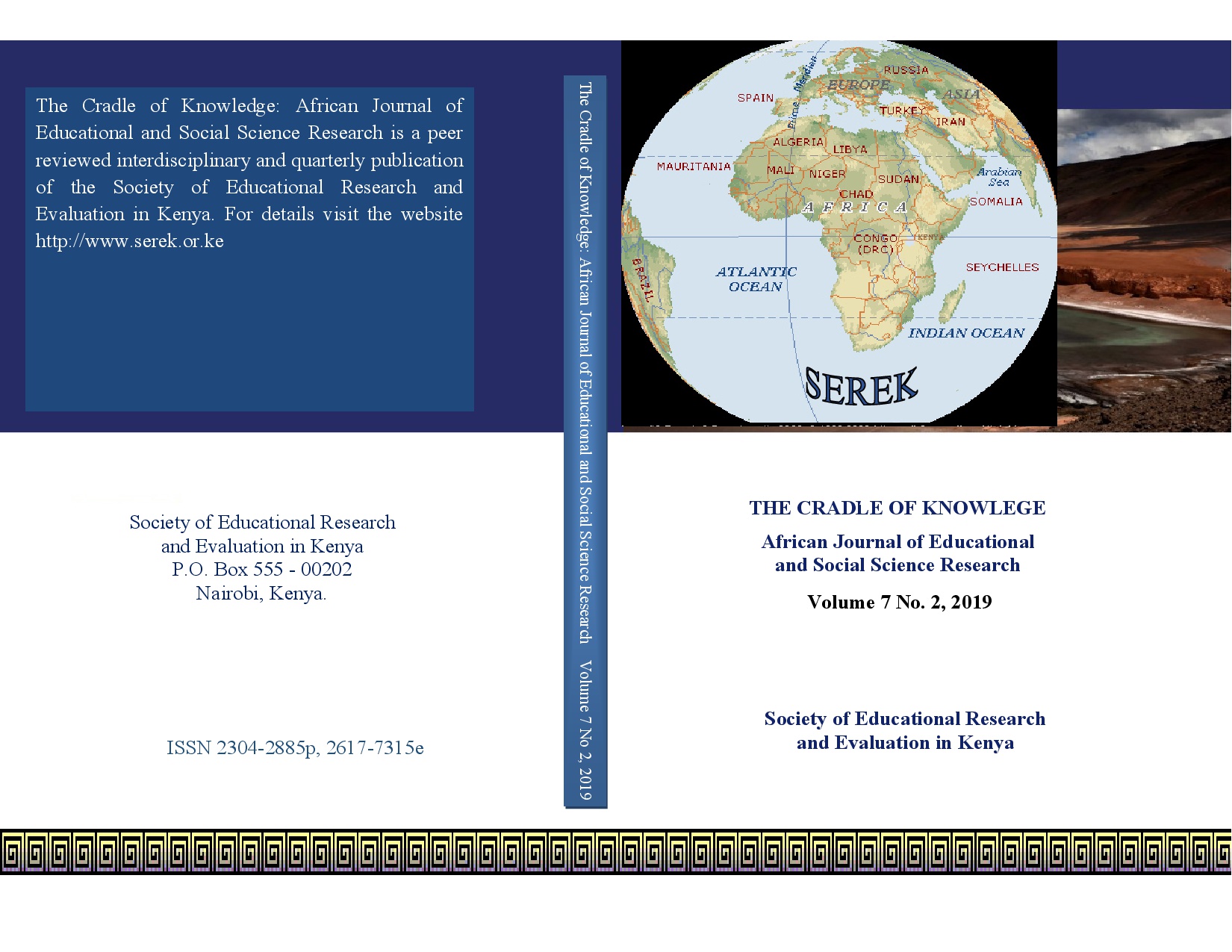
Effectiveness of Transformative Instructional Model on Acquisition of Selected Vocational Skills among the Vulnerable Youth in Nakuru County, Kenya
Abstract
Educators and community trainers have identified the critical role that practical vocational skills can play in the development of broad-based capabilities among the youth. However, the question is whether instructional methods used for practical skills are sufficient to prepare trainees with potentials that reflect and model content productively. This paper presents findings of a study conducted to determine the effectiveness of structured group learning model (SGLM) in acquisition of vocational skills in handicrafts among the vulnerable youth in Nakuru County. The study used quasi experimental design. The Population of the study was 200 identified vulnerable youths in the County. A sample size of 60 members was purposively selected for the study, 30 youth were used as experimental group and the other 30 as control group. Experimental group was trained using (SGLM) methods and a control group was trained through traditional methods. The research instruments were validated and pilot tested, the reliability analysis yielded an index of 0.89 which was sufficient for the study. Data was collected using a guided questionnaire and observation checklist after the training. Pearson chi square was used to test the association between SGLM and acquisition of vocational skills at a significant level of 0.05.The results revealed that there is an association between SGLM and acquisition of some facets of vocational craft skills but not in skill on developing patterns, specifications, branding and packaging of finished products. The Model could be an alternative training strategy for vulnerable youth as it empowers the youth with necessary skills for productive livelihood.
Keywords: Handicraft skills; Structured Group Learning Model; Traditional; Transformative learning; Vulnerable youthFull Text:
PDFReferences
Ahmad, A. Khair, M., Dayana, N., Ali, F., Nabil, A., & Ablatip, N. (2017). Practices in vocational teaching methods to improve the quality of teaching. The social sciences, medwell journals, 12(3) pp413-418
Ahmad, A. Nordin M.., Ali, D. & Nabil, A. (2015). Conducting hands-on task in vocational education: teaching methods in automotive courses. Journal of technical education and training (JTET), 7(1) pp23-34.
Blair, E. (2012). "Etsy crafts a strategy for staying handmade and profitable". Retrieved from NPR. website on22 May 2016
Halim, A. Muda, M. & Wang, M. (2011). An entrepreneurial transformation of Malaysian craft-makers into craftpreneurs: A Conceptual Study. International Business and Management Journal. 2(2), 91-97. Retrieved from International Business and Management, website- Feb 2016
Joanna, B., Stephen, S. & Ivor, G. (2013). Transformative Learning for a Sustainable Future: An Exploration of Pedagogies for Change at an Alternative College Sustainability. Retrieved from www.mdpi.com/journal/sustainability. (5), 5347-5372;(DOI) 10.3390/su5125347 ISSN 2071-1050 June 2017
Lucas, B. (2014). Vocational Pedagogy: What it is and why it matters. Retrieved from University of Winchester website –May 2016
Lucas B., Spencer, E. & Claxton, G. (2012). How to teach vocational education: A theory of vocational pedagogy. City & Guilds Centre for Skills Development. Retrieved from University of Winchester website.
Mashantile, M. (2011). Mzansi’s Golden Economy: Contribution of the arts, culture and heritage sector to the new growth path South Africa. AMERU. Retrieved from Wits University website
Mezirow J. & Tyler, J. (2011). Transformative learning practice: Insights from community work place and higher education.
Mezirow, J. 1997 “Transformative Learning: Theory to Practice.” In P. Cranton (ed.), Trans- formative Learning in Action: Insights from Practice. New Directions for Adult and Continuing Education, 74. San Francisco: Jossey-Bass.
Millis, B. J. (2010). Cooperative learning in higher education: Across discipline, across the academy. Stylus.
Mondugwa, A. (2012). Achieving better teaching and learning in TVET: Effective Strategies for quality teaching and learning. Presentation on the third international congress on TVET and VETA Retrieved from Common wealth of learning website
Morton, M., & Montgomery, P. (2011). Youth empowerment programs for improving self-efficacy and self-esteem of adolescents. The Campbell Collaboration. Retrieved from www.campbellcollaboration.org June, 2017
Reeves, M. (2011). Measuring the economic and social impact of arts. Retrieved from https://issuu.com/craftscouncilofireland/docs/irish-craft-portfolio-2010
Reichenbach M. Muth A. & SmithS. (2013). Transformative learning in Practice: Examples from Extension Education. Journal of Extension Studies. Retrieved from
Rende, R. (2017). Discover the Lasting Benefits of Arts and Crafts: Lets Bond for more information. Retrieved from www./letsbond.elmers.com/content/pdfs/ExecutivePDF.pdf
Sarosa, D. (2010). Model-innovative learning model soft skill to develop for students. Retrieved August 2017.
Schwarz, M. &Yair, K. (2010). Making value; Making value crafts and the economic and social contribution of makers. Retrieved from https://blueprintsfiles.s3.amazonaws. com/1321212530- making_value_full_report.pdf
Tatarkowski, M.& Duckett, I. and (2005). Practical strategies for learning and teaching on vocational programmes. Learning skills development agency. London W1F 7LS. Retrieved from http://www.LSDA.org.uk
Thomas G. & Amaechi, J. (2016). Strategies of effective teaching and learning practical skills in technical and vocational training programmes in Nigeria. International journal of scientific research engineering & Technology. 5 (12) pp 598-603.
UNICEF (2011). Youth situations review & investment in Kenya. Nairobi: Author. Retrieved from Institute of economic affairs. Website.
Yasunaga, Mari, (2014). Non-formal education as a means to meet learning needs of out-of-school children and adolescents. UNESCO. Institute of statistics. Retrieved August 2017, Institute of economic affairs website.
Refbacks
- There are currently no refbacks.
SEREK publication https://serek.or.ke
This work is licensed under a Creative Commons Attribution 4.0 International License